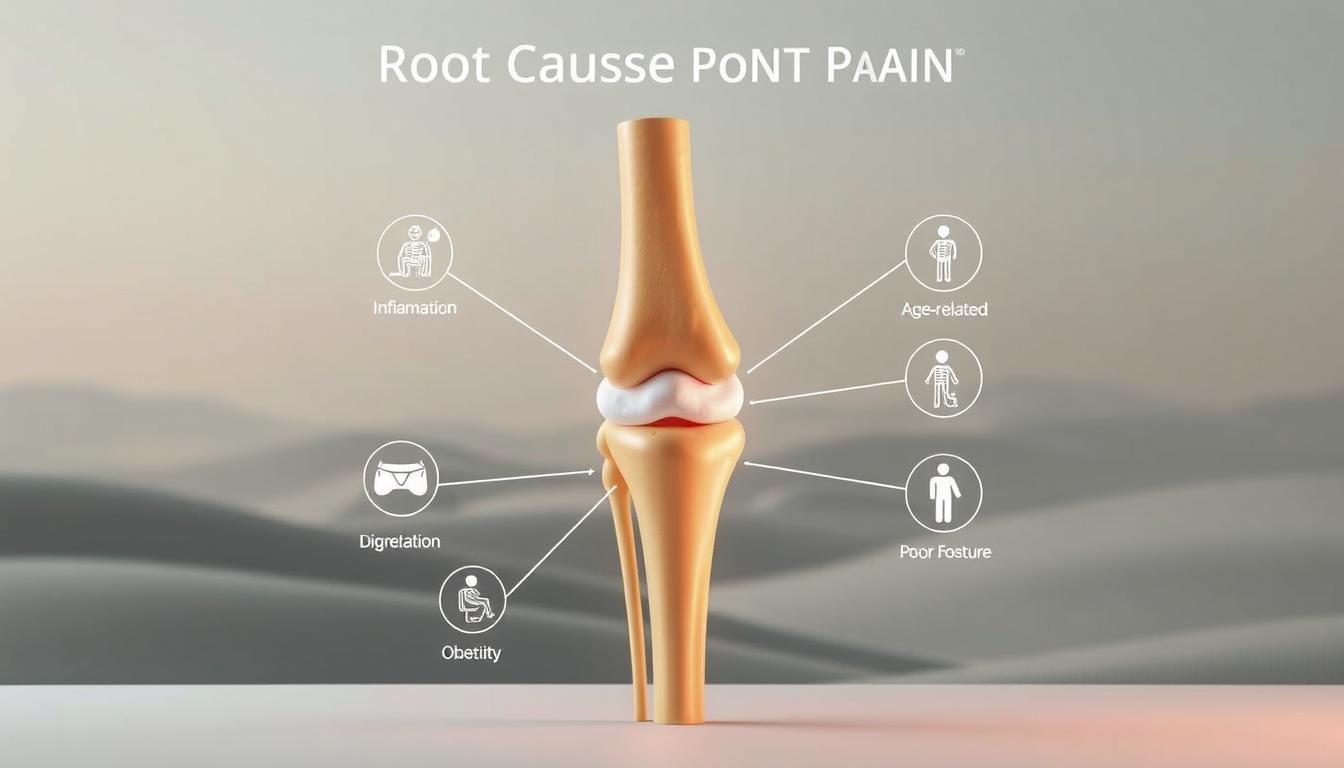Joint pain can make simple movements hard. It might cause stiffness in your knees, aching hips, or discomfort in your hands. Finding out why you’re in pain is the first step to feeling better.
This article will help you find the cause of your joint pain. Signs like swelling or tenderness often point to deeper problems. These can include arthritis, past injuries, or metabolic issues. Knowing this helps doctors give you the right treatment.
Not treating the real cause can make your pain worse. It can also reduce how well you can move. By tackling the root cause, you can find lasting relief and improve your life.
Key Takeaways
- Identifying the root cause of joint pain is essential for targeted care.
- Symptoms alone rarely reveal the true reason for persistent discomfort.
- Conditions like osteoarthritis or gout require specialized diagnoses.
- Ignoring underlying causes delays effective treatment options.
- Discovering the root cause leads to personalized strategies for pain management.
Understanding Joint Pain and Its Impact
Joint pain affects millions, making daily life tough. Knowing the signs early helps in diagnosing joint pain. It’s key to understand the causes and effects to manage it well.
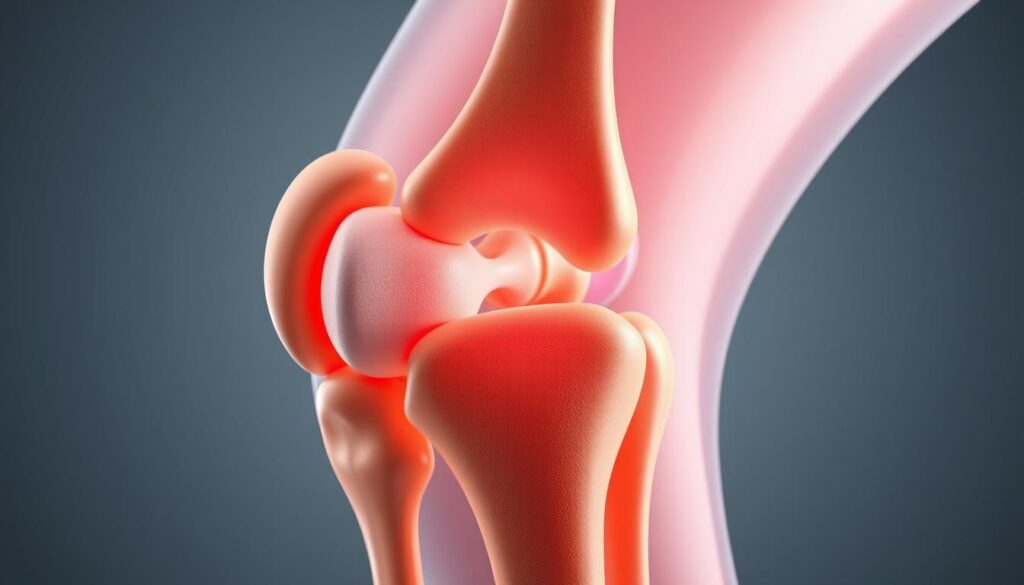
Defining Joint Pain
Joint pain is discomfort in areas where bones meet, like knees or hips. It can come from arthritis, injuries, or too much use. To diagnose joint pain right, doctors look at symptoms, medical history, and possible causes.
How Joint Pain Affects Daily Life
It brings many challenges:
- Walking or climbing stairs is hard
- It’s tough to grip things like doorknobs
- Less energy for hobbies or work
The Emotional and Physical Toll
It causes swelling, stiffness, and less mobility. Emotionally, it can lead to anxiety or depression. It also affects relationships and job performance, showing the need for early joint pain diagnosis.
Common Misconceptions About Joint Pain
Many people think joint pain is just a sign of getting older. But this simple view can hold back finding the real identifying joint pain reasons. Let’s clear up some common myths:
- Myth 1: “Pain always means old age.” But joint pain isn’t just for the elderly. Injuries, inflammation, or bad posture can also cause it.
- Myth 2: “Ignoring pain makes it go away.” Using too much over-the-counter medicine without fixing the real problem can make things worse. This is true for conditions like arthritis or overuse injuries.
- Myth 3: “All joint issues heal on their own.” But some problems, like gout or tendon tears, need specific treatments to get better.

“Misdiagnosis often stems from believing common myths instead of seeking evidence-based answers,” says Dr. Emily Carter, an orthopedic specialist.
By not believing these myths, we can better find the identifying joint pain reasons through proper checks. Taking action early can stop long-term damage. This way, we make sure we’re treating the real cause, not just guessing.
Discover what is the root cause of your painful joints
Finding the source of joint pain begins with a detailed root cause analysis for joint pain. This method looks beyond quick fixes to uncover hidden causes. Doctors dig deep to find lasting solutions.
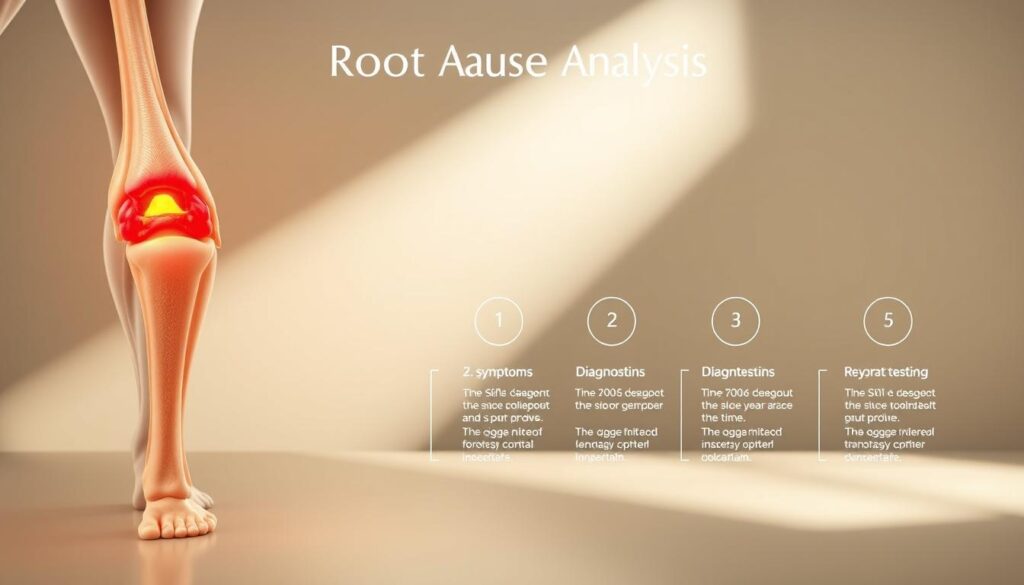
Identifying Underlying Factors
Important factors include:
- Genetic markers linked to conditions like osteoarthritis
- Past injuries or repetitive motions stressing joints
- Obesity placing pressure on knees and hips
These elements can combine in ways that standard tests miss. A specialized evaluation is needed.
When Symptoms Don’t Tell the Whole Story
“Pain location rarely matches the true issue,” notes the Mayo Clinic. “Inflammation from diet or metabolic changes can cause joint discomfort indirectly.”
Swelling knees might come from poor posture, not arthritis. Morning stiffness could point to sleep habits or vitamin deficiencies. A detailed approach is needed to find these connections.
A root cause analysis for joint pain involves tracking daily habits, medical history, and environmental exposures. This helps pinpoint the main issue.
Diagnostic Approaches for Joint Pain
Finding the cause of joint pain needs a blend of exams and tests. Doctors use patient history, physical checks, and technology to pinpoint joint discomfort source. This way, treatments can really help. Early diagnosis helps avoid long-term damage and speeds up recovery.
Medical Evaluations and Clinical Examinations
Doctors first ask about your health history and symptoms. They look for patterns like morning stiffness or pain when you move. Physical exams check for joint flexibility, swelling, and tenderness to find problems like ligament tears or bone misalignments.
- Patient interviews uncover injury history or family conditions like osteoarthritis.
- Range-of-motion tests reveal which joints are most affected.
- Pressure tests pinpoint exact pain locations, narrowing down possible diagnoses.
Imaging Techniques and Lab Tests
Special tools show joint damage clearly. Tests like MRI scans or blood work find hidden problems not seen in physical exams.
| Test Type | Purpose | Key Details |
|---|---|---|
| X-ray | Bone alignment and fractures | Quick, affordable, but limited to hard tissues. |
| MRI | Soft tissue damage | Shows cartilage tears or ligament injuries in detail. |
| Blood tests | Inflammatory markers | Tests for rheumatoid factor or CRP levels to detect autoimmune issues. |
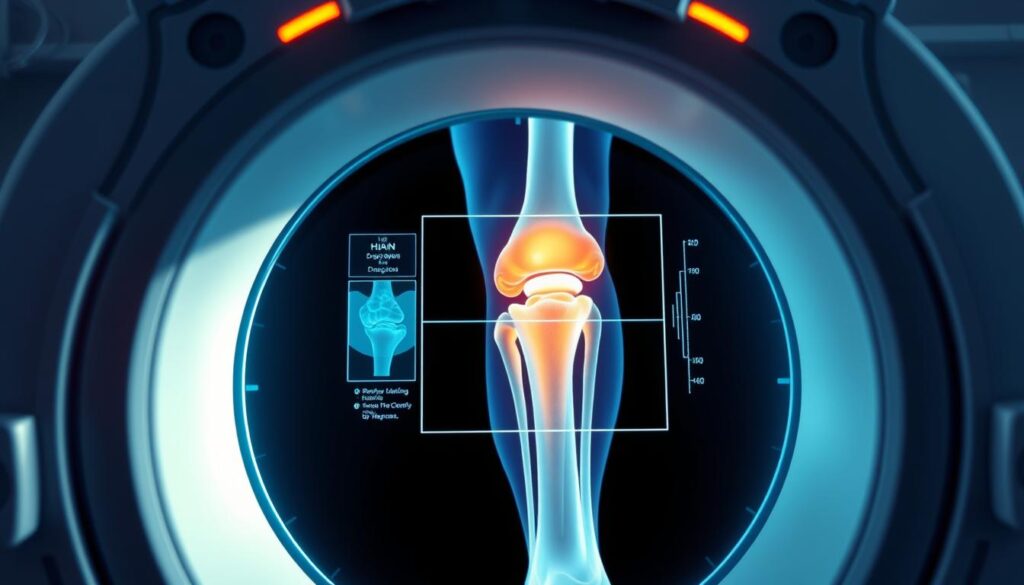
Using all these methods makes sure no detail is missed. Patients should ask about test results to understand their condition better.
Lifestyle Factors and Their Role in Joint Health
Discover how daily habits affect joint health. Making small changes in diet, activity, and rest can help. A balanced lifestyle supports both physical and mental health, leading to lasting relief.

Impact of Nutrition and Exercise
A healthy diet is crucial for joint health. Foods like salmon or walnuts, rich in omega-3s, reduce inflammation. Avoid foods high in processed sugars and saturated fats, as they can make swelling worse. Hydration is also important—it helps keep joints flexible and prevents stiffness.
- Eat colorful veggies: berries, leafy greens, and turmeric contain antioxidants.
- Strength training builds muscle, easing pressure on joints. Low-impact moves like swimming or yoga are ideal.
Stress and Sleep Considerations
Stress can slow healing and worsen joint pain. Aim for 7–9 hours of sleep each night. This allows your body to repair tissues and reduce inflammation.
Practices like meditation or deep breathing can lower stress hormones. Quality sleep also boosts your immune function, aiding recovery. Keeping a regular sleep schedule improves joint resilience.
Alternative Therapies and Natural Remedies
When diagnose painful joints shows conventional methods aren’t enough, many turn to alternative therapies. These approaches blend modern medicine with natural practices to address pain holistically.
Complementary and Integrative Approaches
Acupuncture and yoga are popular choices. Both focus on improving mobility and reducing inflammation. A 2023 study in the New England Journal of Medicine noted acupuncture reduced knee pain by 40% in trial participants.
“Movement therapies like tai chi enhance joint flexibility without straining tissues.” – Arthritis Foundation
Herbal and Nutritional Supplements
Herbal remedies often combine with doctor-approved treatments. Common options include:
- Turmeric (curcumin) for anti-inflammatory effects
- Ginger extracts to soothe joint stiffness
- Omega-3 fatty acids from fish oil
| Therapy | Benefits | Risks |
|---|---|---|
| Acupuncture | Pain relief without medication | Mild bruising possible |
| Herbal supplements | Long-term inflammation reduction | Potential drug interactions |
Always consult a healthcare provider before starting new therapies. Combining these methods with prescribed treatments can create a balanced path toward pain management.
When to Seek Professional Advice for Joint Pain
Joint pain that doesn’t get better with rest, exercise, or over-the-counter treatments might need a doctor. finding the cause of joint pain is urgent if it affects your daily life or shows warning signs.
“Persistent joint discomfort isn’t normal—early evaluation prevents irreversible damage,” states the American College of Rheumatology.
- Sudden inability to bear weight on a joint
- Visible swelling or warmth around the affected area
- Pain that wakes you at night
- Joint deformity or locking sensations
| Symptom | Action |
|---|---|
| Unexplained weight loss + pain | Visit a rheumatologist |
| Joint redness with fever | Seek emergency care |
| Pain lasting >3 months | Request imaging tests |
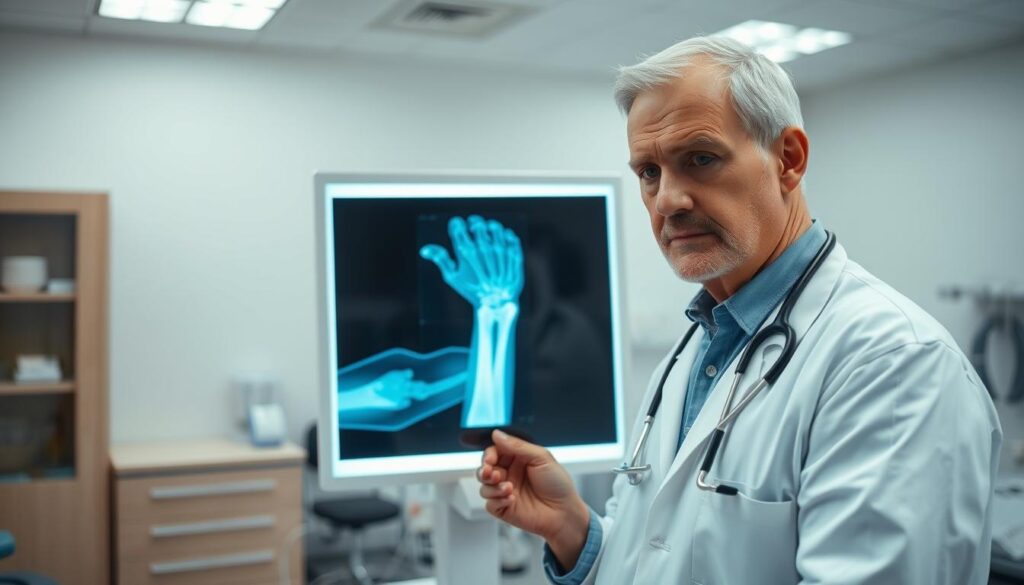
Ignoring severe or worsening symptoms can delay diagnosis. finding the cause of joint pain through expert exams can reveal arthritis, fractures, or infections. Specialists use X-rays, blood tests, or MRIs to find the root cause. Don’t wait—timely care can prevent long-term problems.
Integrating Medical and Lifestyle Solutions for Pain Relief
Managing joint pain well needs a mix of medical advice and lifestyle changes. First, find out what’s causing the pain. Then, create a plan that fits your life for better pain relief.
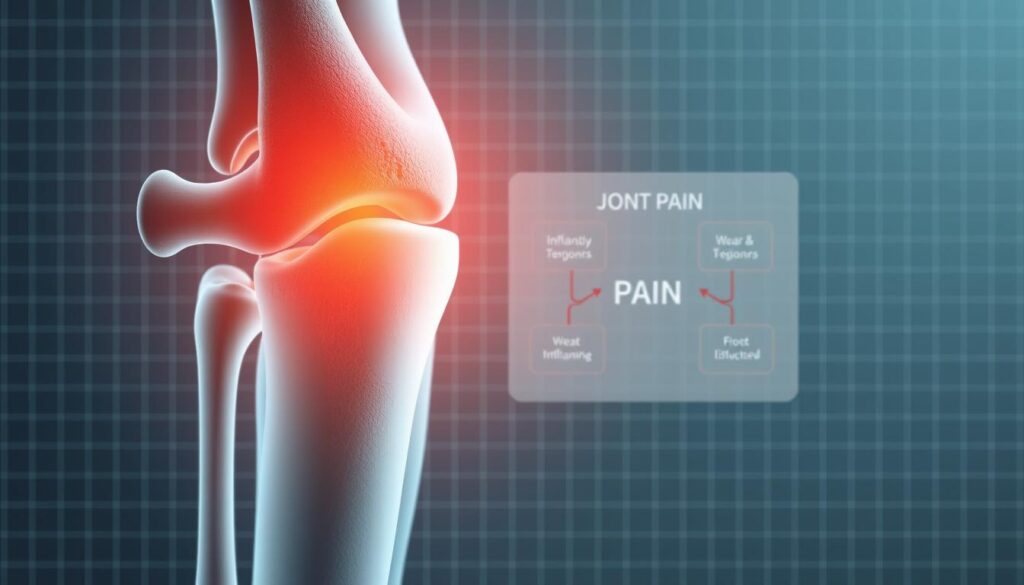
Combining Treatments for Optimal Results
Begin with a doctor’s check-up to figure out the cause. This could be arthritis or an injury. Then, mix treatments with daily habits for lasting relief.
- Medication: Use anti-inflammatory drugs as directed.
- Exercise: Gentle stretching or swimming builds strength.
- Nutrition: Omega-3s and vitamin D-rich foods reduce inflammation.
Holistic Health Strategies
A holistic plan looks at all parts of care. Here’s how medical and lifestyle steps work together:
| Medical Approaches | Lifestyle Strategies |
|---|---|
| Physical therapy | Weight management |
| Injections or surgery | Stress reduction techniques |
| Lab testing for conditions | Sleep improvement routines |
Keep in touch with your healthcare team for updates. Small changes can lead to big improvements with the right advice.
Conclusion
Discover the real remedy here.
Joint pain relief often needs more than one solution. Finding relief means tackling the root causes like inflammation, injury, or chronic conditions. A good plan combines medical checks with lifestyle changes for lasting results.
Tools like imaging and lab tests help find hidden problems. Therapies like physical therapy or supplements help in recovery. Adding diet changes and low-impact exercise strengthens joints naturally.
Getting enough sleep and managing stress also helps, as studies from the Arthritis Foundation show. Medical advice is key for a plan that fits you. Talk to experts like rheumatologists or physical therapists to make a plan.
Start today by trying proven methods like anti-inflammatories, yoga, or ergonomic changes. A plan that balances science and self-care is the best way forward.
